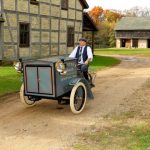"Walter," the Harley-Davidson Forecar pays a Visit to the Museum

Mike Schuster stands with “Walter,” the 1913 Harley-Davidson Forecar he has been restoring for about 40 years. The only one known to exist, it will be on display at the National Motorcycle Museum through Spring 2015.
How did three-wheeled motorcycles like this Harley-Davidson Forecar come about? In 1913, there was strong competition between motorcycle, automobile and truck manufacturers. In addition to providing personal transportation vehicles, each manufacturer sought to design machines they could sell in vast quantities to businesses needing to transport goods.
With “super highways” not yet on the drawing boards, large volumes of goods were transported by railroads in 1913. Locally, big and small trucks broke down these loads and made deliveries to businesses, retailers. But there was still a need to get small quantities of merchandise to shops, or even to the final consumer, or provide door-to-door services like knife sharpening. Machines like the Indian Traffic Car, also on display in the Museum, the three-wheeled Wells Fargo American motorcycle and this Harley Forecar fit into this final category of local delivery, as did some of Harley’s sidecar based “trucks” and Servi-Cars.
Looking closely at this Forecar design, we see a fairly typical main motorcycle frame and drive train, but a stout angle iron frame for the “box” and a steerable front axle similar to the front axle of a car; linkages connected to the handlebar/steering stem made the front wheels steer. Rare in 1913 was the Harley-Davidson two-speed rear hub. Given the weight of the machine, the need to pull hills, perhaps run at low speeds with heavier loads, a low gear was useful.
Few of these Forecars were made and very little is known about them. This is the only example known to exist. It was used by a Harley vendor in Milwaukee, then sat in a barn 40 years and has been under restoration for the past 40 years by its long time owner Mike Schuster. On display temporarily, probably through Spring 2015, it will be the topic of an upcoming documentary; The Missing Link: Discovery of a Centennial Motorcycle.












